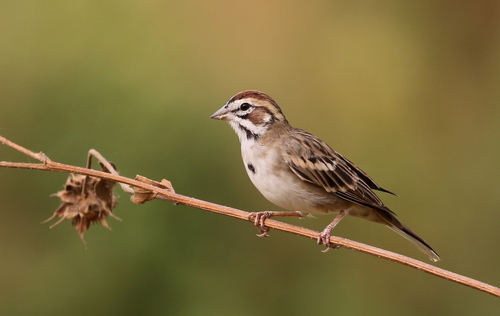
Lark Sparrow
The Lark Sparrow (*Chondestes grammacus*) is a distinctive sparrow of North America, known for its striking head pattern and melodious song. It plays an important ecological role as a seed disperser and consumer of insects, contributing to the health of grassland and open woodland ecosystems. While not typically associated with strong cultural symbolism, its attractive appearance and song have made it a favorite among birdwatchers.
14-17 cm
Length
25-28 cm
Wingspan
Least Concern
Conservation Status
Distribution
Breeds across central and western North America, from southern Canada to northern Mexico. Winters in the southern United States and Mexico. Some populations are resident year-round, while others are migratory.
Lifespan
Up to 6-7 years in the wild, though average lifespan is likely shorter.
Lark Sparrow's Habitat
Habitat Types
Grasslands, Prairies, Savannas, Open woodlands, Agricultural fields (especially with hedgerows)
Climate Zones
Temperate, Semi-arid
Adaptations
Their coloration provides camouflage in grassy environments. Strong legs and feet are well-suited for ground foraging.
Variations
Two recognized subspecies: *C. g. grammacus* (eastern) and *C. g. strigatus* (western), differing slightly in plumage and size.
Appearance
Breeding Plumage
Breeding plumage is more vibrant, with bolder head markings. Non-breeding plumage is slightly duller.
Seasonal Feather Changes
Subtle changes in brightness and contrast between breeding and non-breeding seasons.
Sex Based Plumage Differences
Minimal; males may have slightly brighter plumage during breeding season.
Notable Features
Distinctive head pattern with chestnut, black, and white stripes., White outer tail feathers visible in flight., Clear, unstreaked breast with a central dark spot.
Diet and Feeding
Primary Foods
Seeds, Insects, Small invertebrates
Foraging Behavior
Forages primarily on the ground, scratching and pecking for seeds and insects. Often forages in small flocks, especially outside of the breeding season.
Specializations
No highly specialized feeding adaptations, but their bill is well-suited for handling a variety of seed sizes.
Seasonal Diet Variations
Diet shifts seasonally, with insects being more important during the breeding season (especially for feeding young) and seeds dominating the winter diet.
Behavior
Social Structure
Generally found in pairs or small family groups during the breeding season. Forms larger flocks in winter.
Communication
A clear, melodic song consisting of trills and buzzes., Various call notes, including a sharp 'chip' and a soft 'seet'.
Migration
Many populations are migratory, moving south for the winter. Migration is typically nocturnal.
Territorial or Group Behaviors
Males defend territories during the breeding season through song and displays. Outside of breeding, they are more tolerant of other individuals.
Conservation
Threats
Habitat loss and degradation (due to agriculture, urbanization, and overgrazing), Pesticide use (reducing insect prey and potentially causing direct poisoning), Climate change (potentially altering habitat suitability and breeding timing)
Protection Programs
Conservation Reserve Program (CRP) in the US (provides habitat on retired agricultural land), Various grassland restoration initiatives
Local National Laws
Protected under the Migratory Bird Treaty Act in the US.
Population Trend
Slightly Decreasing
Population Estimates
Estimated global population of 11 million.
Interesting Facts
The Lark Sparrow's genus name, *Chondestes*, comes from Greek words meaning 'grain eater'.
This refers to their seed-heavy diet, especially during the winter months.
They are known for their habit of running along the ground rather than hopping.
This behavior is helpful for foraging in dense grass.
The oldest recorded Lark Sparrow lived to be at least 6 years and 2 months old.
This individual was banded and recaptured.
Faqs about Lark Sparrow
What do Lark Sparrows eat?
They primarily eat seeds and insects, with the proportions varying seasonally. They forage on the ground.
Where do Lark Sparrows build their nests?
They build cup-shaped nests on the ground, usually well-hidden in vegetation.
Are Lark Sparrows migratory?
Many populations are migratory, breeding in the northern parts of their range and wintering in the south. Some populations are resident year-round.
How can I attract a Lark Sparrow?
Plant native grasses and wildflowers to offer seed and shelter. Offer a bird bath for a reliable water source.
Copyright @ Nature Style Limited. All Rights Reserved.
 English
English